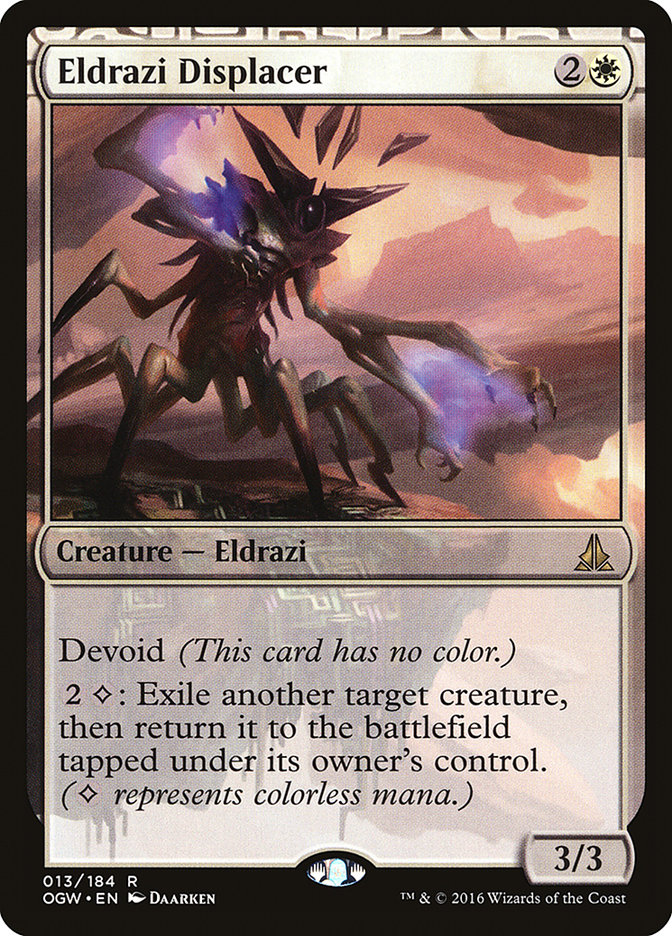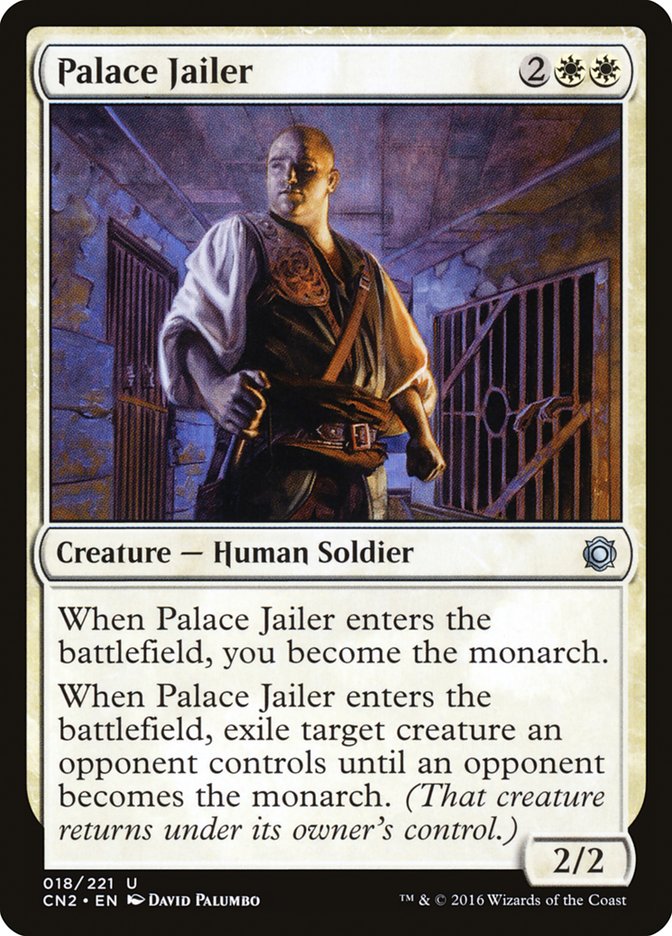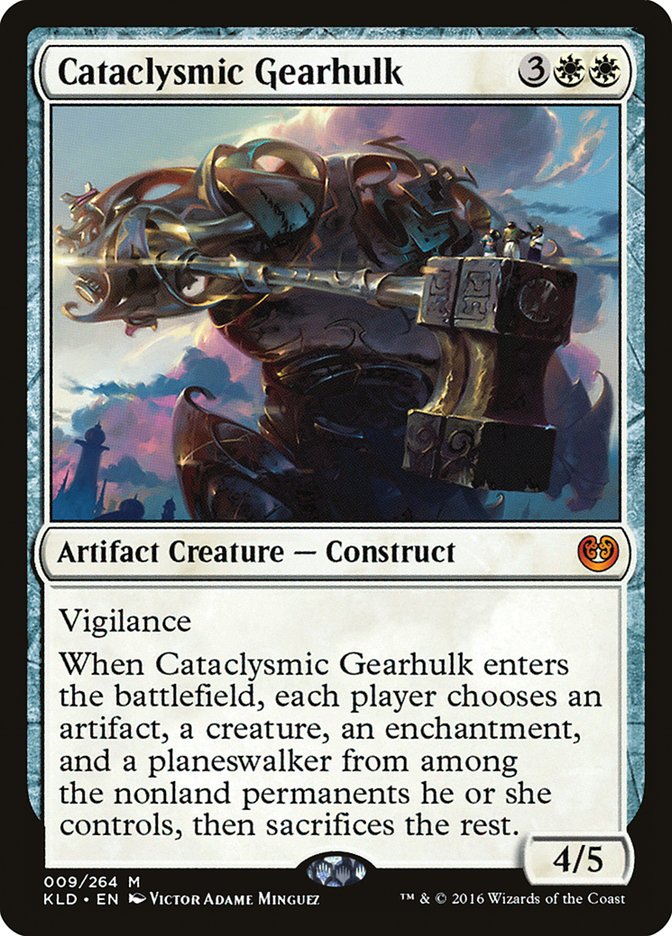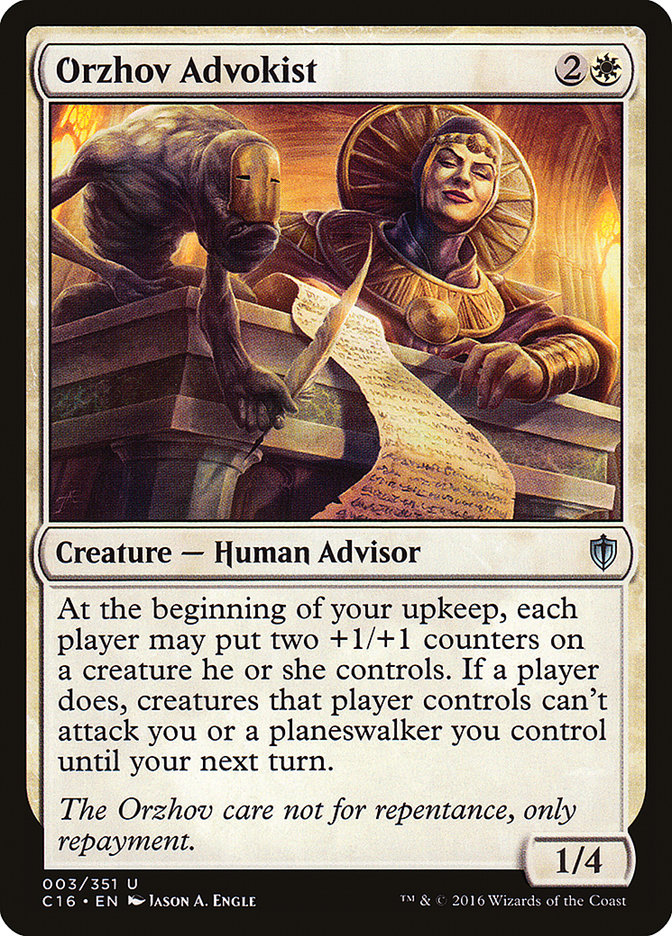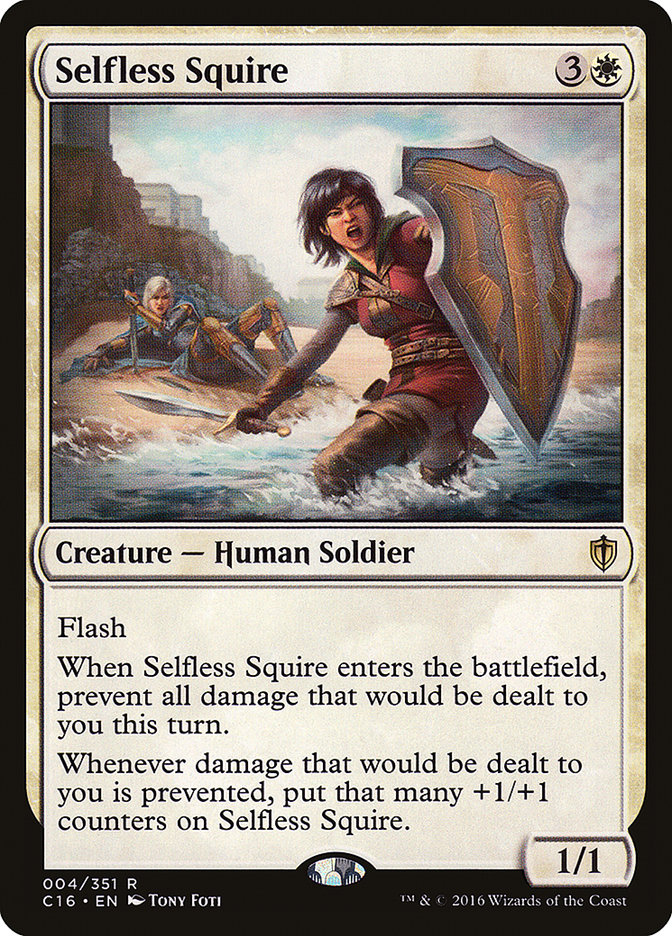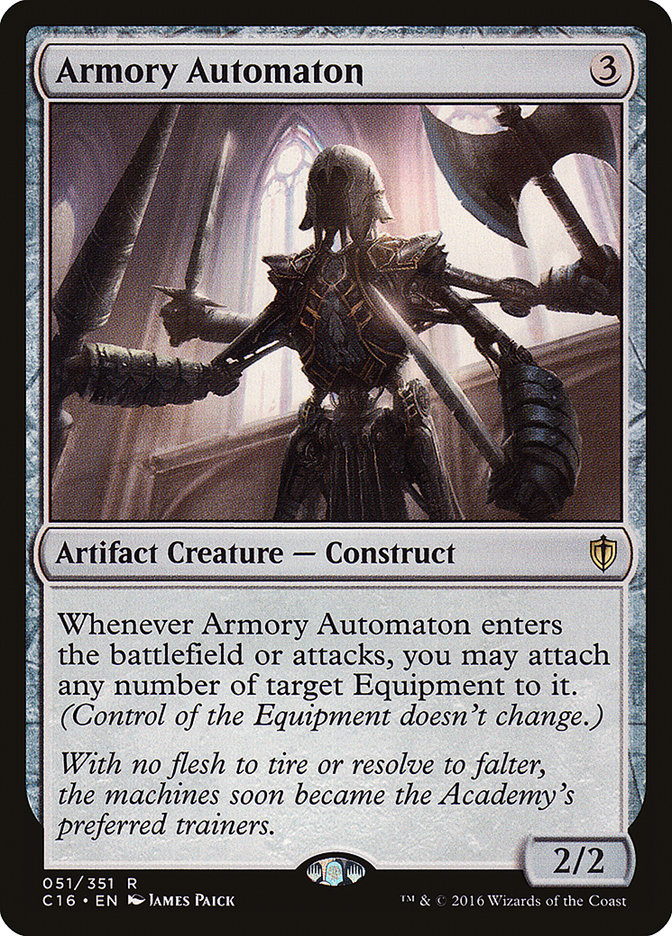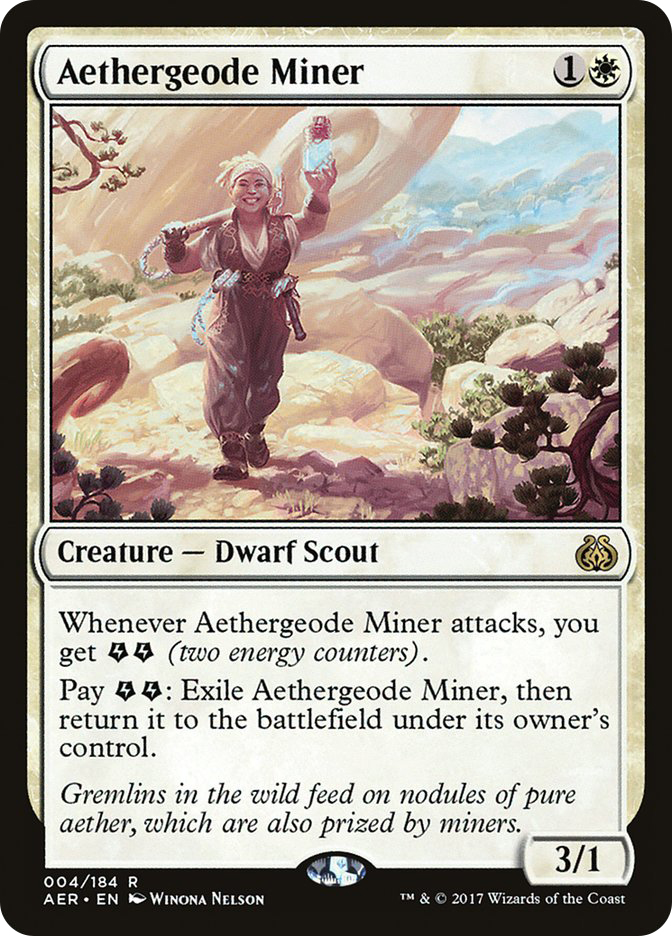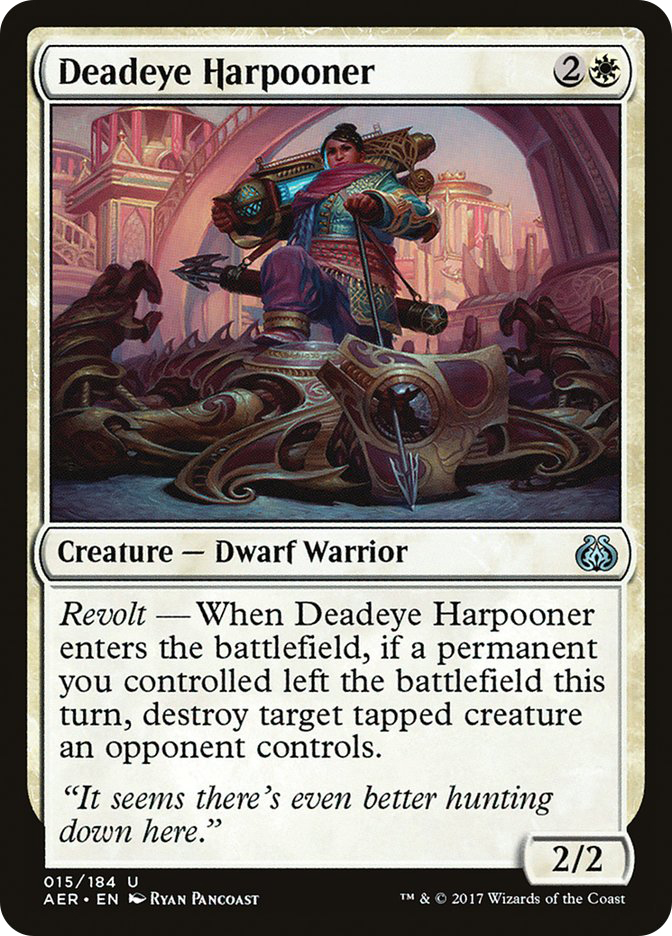For the first time in a while, there was no struggle this week. No need to brainstorm with friends or flip through endless cards hoping for inspiration. With the next stop on the SCG Tour being in Worcester for the first Legacy event in a while, and with the other two formats being pretty stagnant right now, what better time to bring you the 2017 edition of the Great Death and Taxes Update?
For those who missed last year’s edition, we’re going to look at the cards released since the last update (July of 2016) and see what could find a home in the Legacy Death and Taxes list. Generally that deck has around four to six flex slots that will vary based on the current metagame or personal taste, and over the past few years those slots have seen a variety of new cards rotate through.
Our last edition did a fairly good job of predicting which cards would see any play in the archetype. Thalia, Heretic Cathar has more or less found a permanent home in many lists, including mine. Her ability to both hit (relatively) hard and slow down the opponent is a one-two punch that perfectly suits the entire gameplan of the deck. Vulnerability to removal is not really an issue when every card in your deck is vulnerable, and the leg up in Wasteland battles is an important plus.
Eldrazi Displacer was in my maindeck for a while but is now in the sideboard, as the card is too slow against some archetypes. Against the very rough Lands matchup, it does very well and is hard to remove for them. The colorless component does some work in the mirror, but it feels pretty bad blinking a Stoneforge Mystic or Flickerwisp. Unless it’s your own, of course.
Gideon, Ally of Zendikar has become very popular in sideboards, not because it can attack for five but because it continually churns out 2/2 creatures that carry Equipment and apply pressure after a Terminus or Virtue’s Ruin. Sometimes you will use the +1 ability to really get aggressive, but Swords to Plowshares is a heck of a Magic card that Miracles (which is one of the best matchups for Gideon) will definitely be keeping in against you.
Here was my list as of Eldritch Moon:
Creatures (25)
- 4 Mother of Runes
- 3 Flickerwisp
- 4 Stoneforge Mystic
- 2 Mirran Crusader
- 3 Phyrexian Revoker
- 4 Thalia, Guardian of Thraben
- 1 Brimaz, King of Oreskos
- 2 Spirit of the Labyrinth
- 2 Thalia, Heretic Cathar
Lands (22)
Spells (13)

As is often the case with Legacy, there were not many changes to the decklist as a whole. Will anything released between then and now crack the code and make a showing? I have a feeling it just might.
Wizards is on record as saying that supplemental sets are a great place to print cards destined for Eternal formats, as they don’t have to worry about the impact on Standard and Modern. Recruiter of the Guard not only deserves a place in the deck, it has completely changed the way the deck is built. Recruiter of the Guard was already a tutor for most cards in the deck, but the majority of lists have now made cuts and changes to the stock list to make sure they can tutor up whatever silver bullet they need. Two or three copies of Recruiter also enable you to shave copies of key elements like Thalia, Guardian of Thraben, which in turn reduces the instances of getting multiples stuck in the hand. The 1/1 body and lack of any evasion are somewhat annoying, but hey, we cannot have it all.
The beefy (in relative terms) part of the Conspiracy: Take the Crown one-two punch was heavily hyped from the get-go. Death and Taxes has issues with decks like Lands and with single cards like Dread of Night, Sulfur Elemental, Virtue’s Ruin, and the Rough side of Rough//Tumble. Knowing what number to name against which deck is a skill, but once that’s acquired, the card can be your best answer. Naming it on two really gives Lands fits, three is great against Sultai, and of course you can totally shut down Storm decks by naming four. The number we can play in the maideck is probably limited, but the ones we do play can completely turn a game on its head.
If you had told me when Conspiracy: Take the Crown was previewed that any card with the monarch mechanic would see tournament play, I would have been highly skeptical. If you had gone on to force me to pick one, I likely would have gone with Custodi Lich…and felt very bad about it. As it turns out, the combination of nigh-permanent exile and a personal Howling Mine effect is very powerful, especially in a format where creature combat is relatively rare. Death and Taxes is adept at keeping opposing creatures incapacitated or off the battlefield entirely, meaning that monarch effect is going to stick around.
The fact that it costs four and that we rarely want to tick our Vial up that high makes the card a sideboard option for the most part, but in Legacy, that is a big compliment. The two toughness also makes it tutorable by Recruiter of the Guard, a key factor in today’s Death and Taxes lists. Oh, and blinking it is just disgusting.
If Cataclysm is good in the sideboard of some lists, then a Cataclysm that can attack for four is even better, right? Right?
Nope.
Let’s look at the differences. First, Cataclysm costs one less. Although that’s not a huge cost to pay for a 4/5 with vigilance, it is a real cost in Legacy. Death and Taxes is more likely to reach five lands than most decks, but even with that being the case, it is rare that we reach that point without some Wastelands (ours or theirs) in the mix. We might be able to put up with that as a trade-off for the admittedly high power if it weren’t for the fact that we would have to sacrifice any Aether Vials or Equipment we might have in order to keep the Gearhulk.
Sometimes that could be worthwhile, especially if the only creature the opponent can keep is a small one. However, that brings me to the biggest difference: Cataclysm also takes away their lands, while the Gearhulk leaves those intact to cast a removal spell or another creature. Just too many strikes against the card for it to break in, which is a shame, because the Masterpiece artwork is beautiful.
There was a time when banning a card in Standard was a rare occurence, but here we sit with three of them. Two are very likely unplayable in this deck, but Smuggler’s Copter has some appeal. My good friend and fellow “small white creatures and mana denial” aficionado Kaylee Mullins has been playing it to significant success in Modern, but to my knowledge the card has yet to break through to Legacy.
What makes the Copter such a good potential fit for Death and Taxes is the plethora of small, non-evasive creatures we play that can crew the Copter without losing any attacking potency. It doubles as a flying threat and a way to filter through our deck, which, in a deck with more than a few silver bullets that are dead in some matchups, is a definite plus. I don’t know that Death and Taxes is uniquely positioned to take advantage of the undoubted power of Smuggler’s Copter, but it is certainly in a good place for it.
The downsides? Well we have no way to tutor it, meaning it either will not often show up or we have to play several. It cannot be Vialed in and its cost is increased by Thalia, Guardian of Thraben. And finally, although it does allow us to get something out of our dead cards, it doesn’t actually do anything to advance our gameplan. Probably worth a look at some point, but I don’t know how many I want to try.
We’re all nerds, right? Well when it comes to Death and Taxes, I am even more of a nerd. I regularly have conversations with other Death and Taxes players about potential additions to the deck, and not one of them agrees with me on Orzhov Advokist. When you like a card that’s awful but it’s fun, so much fun…the brewer’s lot is not a happy one.
Okay, it’s not terrible. In fact, I really like the ability to both grow our own team and give our opponents the choice of growing their own or letting us develop without any pressure being applied. It might be even better against decks that are not running many creatures, as we get to add two power to the battlefield each turn for free. We cannot search it up with Recruiter of the Guard, but on its own it is a decent blocker that resists a lot of removal and has a very potent ability. It’s low-impact on the turn we cast it, but after that it really makes a difference.
Have you ever been to Magical Christmas Land? I have. It is a wondrous place, full of Magic and…er, Christmas. And Selfless Squire blowouts.
My attraction to this card is rooted almost entirely in its applications against decks that look to deal a bunch of damage to you in a hurry: Elves, Lands, and even Miracles in some matches can just kill you with one combat step. Not only does Selfless Squire stop that, it also leaves you with a giant creature that will probably be able to attack unblocked. For lethal, in all likelihood. My only regret is that protecting creatures with Mother of Runes doesn’t put counters on Selfless Squire.
While the differences are obvious, there are some similarities between Selfless Squire and another four-mana creature: Seht’s Tiger. I don’t know who Seht was or why he kept a tiger, but it’s a card I have often wanted to play and never managed to justify because so few decks rely on damage from sources of one color. It does protect against Tendrils of Agony (which Selfless Squire cannot do), but otherwise the effect is a little too limiting.
Although all the relevant examples in Legacy are single-color ones, the body that Selfless Squire gives us is leagues above a 3/3. There are some minor advantages to be found in the creature type (Human is often what we name on Cavern of Souls) and the mana cost (3W is of course easier to cast). In the event that we cannot win with one swing from the Squire, we can also blink it if necessary to repeat the process next turn. Because that’s fair.
I’ll be really quick on this one: not worth the effort. Although I can definitely see the applications in the mirror or in matches against the likes of Stoneblade decks, there will be many occasions where it just does nothing. Stealing an opposing Umezawa’s Jitte is probably the best application, but any competent player will use the counters in response (probably to kill the Automaton), and if there are no counters, they will just re-equip next turn and attack. High ceiling, but very low floor. I could see an argument for a sideboard slot in metagames where there is a lot of Equipment being played, but otherwise the Automaton will not make it off the bench for me.
The energy mechanic is parasitic, but some cards do both provide and use energy. Aethergeode Miner is one of the few that provides enough energy to use it and does something useful in the context of the game. I’ve often found myself in a position where I wanted to dodge point removal or avoid Jitte triggers or lifelink for my opponent, and without Mother of Runes, we aren’t really able to do that. After one attack, the Miner has this built-in protection that can also play nicely with some fringe inclusions like Anafenza, Kin-Tree Spirit and Auriok Champion. The 3/1 body is already something we are willing to play, and although the blink ability is less flexible than Flickerwisp (of course), it does have the potential to provide a resilient threat against decks with plenty of removal.
The downside is that we do need to make it to combat before we can ever blink it, because there are really no other energy-making cards that we would want to play. Get it on the battlefield early enough and that shouldn’t be a concern, but if we get it late, that could be a challenge. I can see this having more application in Modern versions where Renegade Rallier and thus revolt are important factors, but in Legacy the benefit is likely not enough to crack the maindeck.
As maligned as this card is in Limited, I actually think it could be viable in this deck. A lot of very large creatures are played in this format, and just being able to destroy one with minimal effort is definitely a plus. The Harpooner plays nicely with Wasteland, Flickerwisp, Eldrazi Displacer, and Thalia, Heretic Cathar. We get to blow up Emrakul, the Aeons Torn sometimes, and we get to blow up Reality Smasher without having to discard a card. The toughness is in the perfect spot to tutor up with Recruiter of the Guard, and the body is a reasonable size. We also don’t have to worry about the opponent dealing with the creature and getting their threat back, as is the case with Banisher Priest or Fiend Hunter.
Where the weakness comes is in the threats that it cannot deal with. Reanimator, for example, runs Inkwell Leviathan, which is essentially unbeatable for Death and Taxes without some very particular sideboard cards. Furthermore, Reanimator really doesn’t mind all that much if you put its threats back in the graveyard! In reality, we could get the same or a similar effect from Intrepid Hero without having to jump through hoops to enable revolt.
If you were to ask me how many games I had stolen thanks to a Mirran Crusader carrying some Equipment, my estimate would be well into the thirties. Double strike is a silly, silly mechanic and it’s even worse when you have effects that trigger on combat damage. Solemn Recruit gives us another double-striking body that doesn’t have innate protection but does get bigger over time. The problem is getting it to stick around that long.
Once the Recruit starts to accumulate +1/+1 counters, most would agree that it becomes a very powerful threat. Although it only gets a counter if revolt is enabled on your turn, that does mean that you can often get it on the battlefield and very quickly make it a 3/3. Without that protection from Abrupt Decay, though, it may never get any bigger. The extra double-striking threat is nice, but the vulnerability is not what I want in a finisher.
Is This the Deck for Worcester?
The great thing about Death and Taxes is that it has very few unwinnable matchups and can beat most decks with the right draws. The gameplan is more effective in some matches than others, but every deck has some aspect that gets shut down by one of the bullets to which we have access. If you have got some reps in with the deck and are comfortable with the lines, you can do a lot worse. This is close to what I would register:
Creatures (25)
- 4 Mother of Runes
- 3 Flickerwisp
- 4 Stoneforge Mystic
- 2 Mirran Crusader
- 3 Phyrexian Revoker
- 3 Thalia, Guardian of Thraben
- 1 Spirit of the Labyrinth
- 2 Thalia, Heretic Cathar
- 2 Recruiter of the Guard
- 1 Sanctum Prelate
Lands (21)
Spells (13)

If you decide to run the deck, whether my 75 or something close, let me know how you do!
That’s all we have for this week, folks. As always, thanks for stopping by, and until next time…Brew On!


